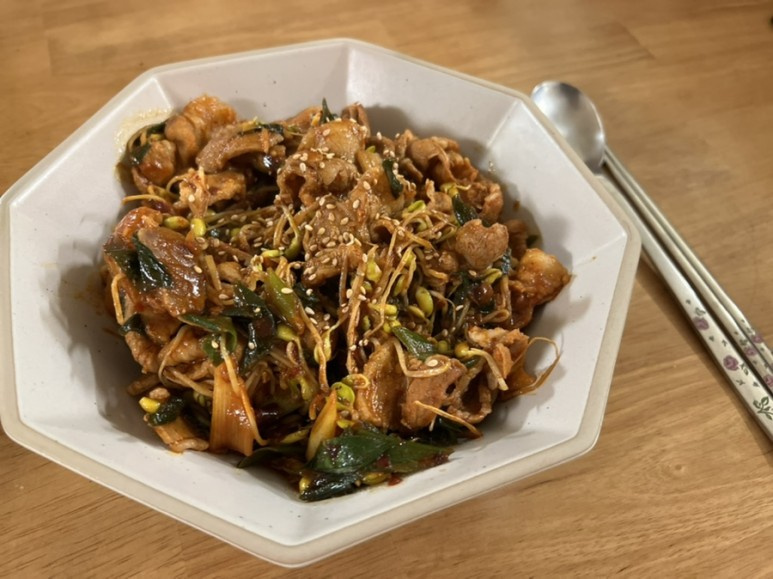Spicy and Sweet Kongnamul Bulgogi
Kongnamul Bulgogi Recipe with a Special Sauce for Enhanced Umami

While thinking about what to make for dinner with my child, I remembered we had bean sprouts at home. I’m so glad my elementary school child can now enjoy spicy food, and we’re exploring new spicy dishes together! I was getting quite tired of soy sauce-based meals. This Kongnamul Bulgogi, always delicious no matter how you make it, is now even better with a special addition to the sauce.
Main Ingredients- Thinly sliced pork (for bulgogi or thinly sliced pork belly) 300g
- Fresh bean sprouts 200g
- Green onions 2 stalks
Special Sauce- 1 Tbsp minced garlic (adjust to taste)
- 2 Tbsp soy sauce
- 2 Tbsp cooking wine (mirin or cheongju)
- 2 Tbsp gochujang (Korean chili paste)
- 1 Tbsp laojang (or oyster sauce)
- 2 Tbsp plum extract
- 1 Tbsp minced garlic (adjust to taste)
- 2 Tbsp soy sauce
- 2 Tbsp cooking wine (mirin or cheongju)
- 2 Tbsp gochujang (Korean chili paste)
- 1 Tbsp laojang (or oyster sauce)
- 2 Tbsp plum extract
Cooking Instructions
Step 1
First, prepare the main ingredients: pork and bean sprouts. It’s best to get thinly sliced pork meant for bulgogi from a butcher. Pork that’s thinner than regular pork belly but thicker than pork belly slices works wonderfully for Kongnamul Bulgogi.

Step 2
Wash the green onions and slice them diagonally. It looks like a lot of green onions after slicing, but since there aren’t many other vegetables, we’ll use them to enhance the flavor.

Step 3
Rinse the bean sprouts thoroughly under running water and drain them. Lay the sliced pork at the bottom of a pot, then arrange the sliced green onions and bean sprouts on top.

Step 4
Now, let’s make the special sauce that will make this Kongnamul Bulgogi truly shine. Start by adding 1 tablespoon of minced garlic. If you enjoy a stronger garlic flavor, feel free to add a bit more.

Step 5
Next, add 2 tablespoons of soy sauce. This will provide the fundamental savory and salty notes.

Step 6
Add 2 tablespoons of cooking wine (like mirin or cheongju). This helps to remove any pork odor and tenderizes the meat, adding a subtle flavor.

Step 7
Add 2 tablespoons of gochujang (Korean chili paste) for that essential spicy kick. It’s the foundation for that beloved Korean sweet and spicy flavor.

Step 8
For a unique depth of flavor, add 1 tablespoon of laojang. Laojang has a distinct taste, often described as chili oil with a hint of Sichuan pepper, and its richness means you don’t need to add extra oil like sesame oil. (If laojang is unavailable, oyster sauce or a little doubanjiang can be used as a substitute.)

Step 9
Finally, add 2 tablespoons of plum extract. This adds sweetness and a glossy finish, balancing the flavors with its mild sweetness and slight tang, unlike plain sugar.

Step 10
Combine all the prepared sauce ingredients in a bowl and mix well. Taste it – you’ll find a delicious harmony of salty, spicy, sweet, and umami flavors. Thanks to the laojang, additional oils are unnecessary.

Step 11
Pour the prepared sauce evenly over the pork, bean sprouts, and green onions in the pot. Cook over medium-high heat, covered. The thinly sliced pork will cook quickly.

Step 12
As the pork cooks, its juices will be released, and the bean sprouts will release their refreshing liquid, creating a savory broth. This process allows all the ingredients to meld together, developing a wonderful flavor.

Step 13
Simmer until the sauce has slightly reduced and all ingredients are cooked through. Once the sauce reaches this slightly thickened consistency, turn off the heat. Your delicious Kongnamul Bulgogi is ready! It’s also fantastic mixed with rice.




